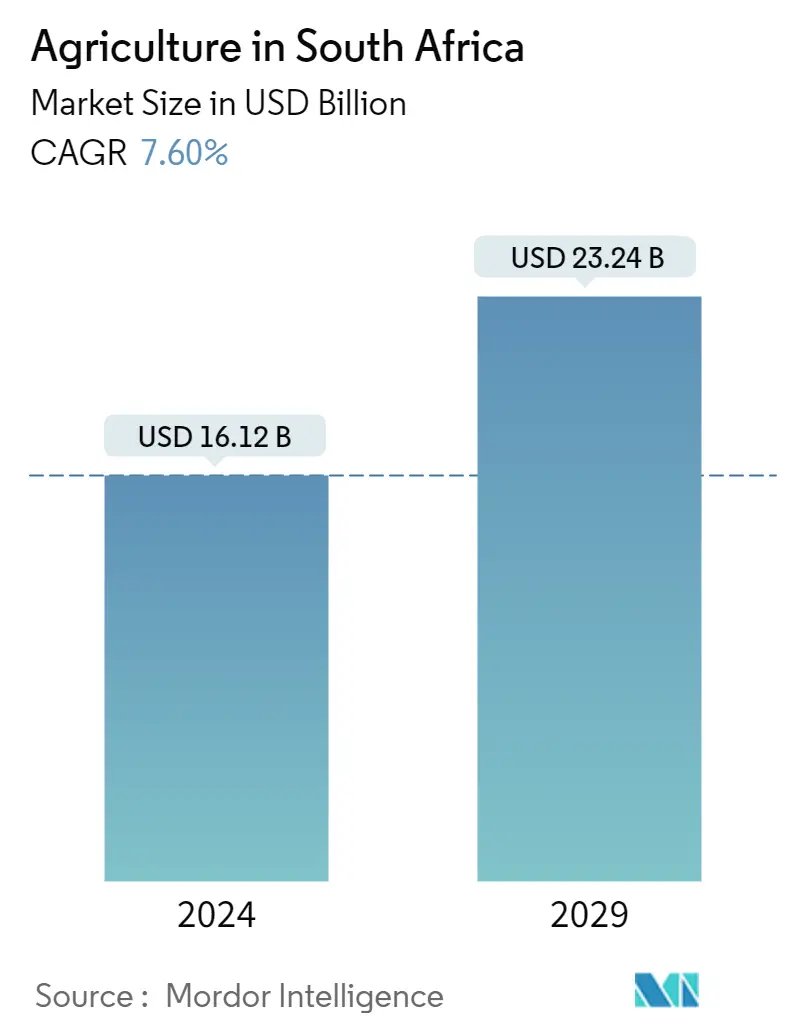Market Size of Agriculture in South Africa

| Study Period | 2019 - 2029 |
| Base Year For Estimation | 2023 |
| Forecast Data Period | 2024 - 2029 |
| Market Size (2024) | USD 16.12 Billion |
| Market Size (2029) | USD 23.24 Billion |
| CAGR (2024 - 2029) | 7.60 % |
Major Players*Disclaimer: Major Players sorted in no particular order |
South Africa Agriculture Market Analysis
The Agriculture in South Africa Market size is estimated at USD 16.12 billion in 2024, and is expected to reach USD 23.24 billion by 2029, growing at a CAGR of 7.60% during the forecast period (2024-2029).
The lockdown restrictions, changing consumer choices, and limited buying power of consumers during COVID-19 have resulted in piling up of stocks of commodities such as potatoes which led to a decline in prices of these commodities.
South African agriculture is highly diversified and market-oriented. The country's major important crops are grains and cereals such as rice, wheat, barley, and soybeans. According to FAOSTAT, the area under grains and cereals production was 2,660.4 thousand hectares in 2016, which increased by 13.1% and reached 3,062.8 thousand hectares in 2019. In 2019, the farm income of South African farmers increased by 4.3%, and the prices that farmers pay for agricultural inputs increased by 5%. This decline in farm income may refrain farmers from using various modern agricultural technologies, which in turn affects agriculture production. The increase in the population level of the country has fueled the demand for cereals. Maize is the staple food in the country, consumed in its direct form, and is used for products such as sweeteners, bread, and cornmeal. Wheat is also another major staple food in the country, which is mostly imported, as it is economical to import rather than produce it domestically. The major fruits consumed in the country are apples, pears, litchis, mangoes, plums, peaches, apricots, grapefruit, pineapples, avocados, and lemons. There is also an increasing demand for products derived from fruits, such as fruit juices and jams, in the country that drives the market. Also, more than 1.5 million metric tons of grapes are used every year domestically in South Africa's renowned wine industry. The most demanded vegetables in the country are lettuce, chicory, pumpkins, tomatoes, and carrots. Apart from these, leafy vegetables, like cleome, amaranth, blackjack, and Jew's mallow, which are locally produced, are also consumed in the country. Most of the country's oilseed demand is met by domestic production. However, palm oil, a well-in-demand oilseed in the country, is currently imported from Indonesia and Malaysia. In the forecast period, the country is expected to reduce imports to a great extent and become self-sufficient in the production of oilseeds.
South Africa Agriculture Industry Segmentation
The report defines agricultural products in terms of the end users. The scope does not include agriculture products processed in any form, such as frozen, freeze-dried, cooked, canned, etc. The Agriculture in South Africa Report is segmented by Crop Type (Cereals, Fruits, Vegetables, and Oilseeds/Non-food Crops), which includes Production Analysis (Volume), Consumption Analysis (Value and Volume), Export Analysis (Value and Volume), Import Analysis (Value and Volume), and Price Trend Analysis for each segment.
| Crop Type | |
| Cereals | |
| Fruits | |
| Vegetables | |
| Oilseeds |
Agriculture in South Africa Size Summary
The agriculture sector in South Africa is characterized by its diversity and market orientation, with significant contributions from grains and cereals such as maize, wheat, and barley. The country's agricultural landscape is shaped by both domestic production and import dependencies, particularly for staples like wheat. The demand for food, especially fruits and vegetables, is driven by rapid population growth, increasing economic prosperity, and shifting consumer preferences towards healthier diets. This demand is further amplified by urbanization and rising incomes, which are transforming dietary habits and boosting the consumption of off-season fruits and vegetables. The South African agricultural market is also influenced by government initiatives and favorable climatic conditions, which support the cultivation of food crops and promote market accessibility for farmers.
The South African agriculture market is poised for growth, with projections indicating a significant increase in market size over the forecast period. The sector's expansion is supported by improved awareness of health and well-being, which has led to a surge in demand for fresh produce. Despite challenges such as climatic variability and knowledge gaps, government policies and projects like Agri-parks and project Khulisa are expected to enhance agricultural productivity and sustainability. The deregulation of marketing has matured the food crop market, allowing for greater flexibility and international trade opportunities for farmers. As the population continues to rise, the need for food security and increased local production of oilseeds and other crops is anticipated to drive the agricultural market forward.
Agriculture in South Africa Market Size - Table of Contents
-
1. MARKET DYNAMICS
-
1.1 Market Overview
-
1.2 Market Drivers
-
1.3 Market Restraints
-
-
2. MARKET SEGMENTATION
-
2.1 Crop Type
-
2.1.1 Cereals
-
2.1.2 Fruits
-
2.1.3 Vegetables
-
2.1.4 Oilseeds
-
-
Agriculture in South Africa Market Size FAQs
How big is the South Africa Agriculture Market?
The South Africa Agriculture Market size is expected to reach USD 16.12 billion in 2024 and grow at a CAGR of 7.60% to reach USD 23.24 billion by 2029.
What is the current South Africa Agriculture Market size?
In 2024, the South Africa Agriculture Market size is expected to reach USD 16.12 billion.

